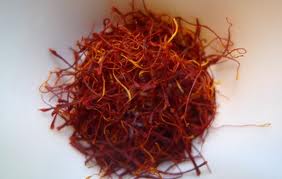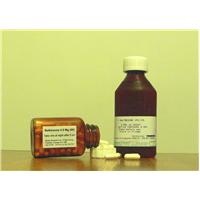Toronto: Researchers have found that a substance in Persian saffron may hold the key to reducing nerve inflammation in sufferers of multiple sclerosis.


Toronto: Researchers have found that a substance in Persian saffron may hold the key to reducing nerve inflammation in sufferers of multiple sclerosis.

The winter is finally here! The weather is colder and the sun sets before most of us even leave the office. How do you know if you are getting enough vitamin D and how much should you consume?
Dr John Cuomo, Executive Director of Research and Development at USANA Health Sciences answers important questions on why this vitamin is so important to the optimum functioning of the human body:
What are the main functions of vitamin D in the body?
Vitamin D appears to have many functions in the body. Every cell, regardless of where it is located has a vitamin D receptor. This would indicate that vitamin D has multiple functions and the scientific evidence backs this up. The best documentation of the importance of vitamin D is in bone health. Absorption and utilization of calcium appears to be a vitamin D controlled process. Other minerals including magnesium, boron and silicon may also depend on vitamin D to be absorbed and deposited into the bone matrix. The RDA data for vitamin D is based solely on the function for uptake and utilization of minerals for bone health. So while bone health, and prevention of osteoporosis is an extremely important function of vitamin D, it is part of what makes vitamin D important to your health. There are numerous studies showing that Vitamin D is also essential for overall immune system function and for muscle strength. Epidemiological studies also show links to glucose metabolism, cell proliferation, osteoporosis, osteomalacia, impaired muscle function, infection, autoimmune disorders, diabetes, some cancers and CVD.
What are the best natural sources?
One of the best ways to get vitamin D is to expose your skin to sunlight. 15 to 30 minutes of sun exposure between the peak hours of 10am-2pm will make thousands of IU of vitamin D. Just be careful not to burn. Dietary sources are lower. Some product such as milk and orange juice are fortified with vitamin D, but the dose is usually low and the form is different than from sun exposure. Some fish also have vitamin D but the amounts vary significantly.
-Is the vitamin D in milk etc a chemically made version and, if so, does it differ (like vitamin e) from the natural source?
The story here is a little different than for vitamin E. The form of vitamin D produced in skin naturally from sunlight is cholecalciferol or vitamin D3. This is also the form used in most nutritiona
l supplements like USANA Vitamin D tablets. Milk is fortified with vitamin D2 or ergocalciferol. While it is naturally derived, it is not the same as the D3 that we produce naturally from sun exposure. In addition there are several clinical studies on supplementation with D2 vs. D3, and it looks like D3 is more bioavailable, and a better choice.
What are the best ways to take vitamin D to ensure you’ve taken enough?
Dietary sources are not sufficient. Even though milk, orange juice and fish do contain vitamin D, all of the data we have seen indicates that the vast majority of Americans are vitamin D deficient. The two best ways to get the vitamin D you need are to get adequate sun exposure to exposed skin (without sun block) or to take a good vitamin D supplement. In addition, the only good way to tell if you have adequate stores of vitamin D is to have a blood test run. If your doctor asks for this test, be sure they measure the amount of 25-hydroxy vitamin D in plasma, and the amount should be 40 – 60 ng/mL.
Does sunscreen stop us absorbing vitamin D?
Yes. To make vitamin D in the skin, UV light must hit the skin directly. Sunscreen effectively blocks this, and almost no vitamin D will be produced if you apply sunscreen.
-How often should vitamin D be taken?
A daily supplement of 200 to 500
IU of vitamin D.
Why is vitamin D important?
It supports healthy bones, immune function, muscle strength, glucose control, and may help prevent auto immune disease and heart disease.


MS sufferer Linda Elsegood (pictured right) could not see or hear properly and had to use a wheelchair before she discovered Low Dose Naltrexone (LDN). Now she has launched her own campaign to increase awareness of the possible use of the drug in MS treatment.
Linda was so crippled by the disease that she was barely able to attend her daughters wedding. Then Lindas life was transformed when she discovered LDN via the internet.
The MS was causing me excruciating pain. It started with a tingling on my tongue, then I just couldnt get out of bed and was sleeping for 20 hours a day, says Linda, from Norfolk.
I was finally diagnosed with Relapsing and Remitting MS. In October 2003, my neurologist told me there was nothing more that could be done for me.
From that moment Lindas deterioration was rapid until she started taking LDN in December 2003 and noticed improvements after three weeks. This continued for two years and then Lindas symptoms stabilised.
LDN uses approximately 1% of the Naltrexone dose approved by the Food and Drug Administration (FDA) for treating alcoholism and drug addiction.
I still have MS but life is good, says Linda. I can set targets and achieve them and look forward to the future.
The other prescribed treatments had horrendous side effects and cannabis was not an option for me.
After my success with LDN, I wanted everyone to know about it. I formed the LDN Research Trust in May 2004 and now spend all my time helping others while trying to raise funds for clinical trials.
Naltrexone is a generic drug that is out of patent, so very cheap to produce. The downside of that is that drug companies will not fund trials as there is no money to be made.
Id like the Government to fund clinical trials as I believe this could change the lives of thousands of people in the UK who suffer not only from MS but also Crohns, cancer and other diseases.
The LDN Research Trust website www.ldnresearchtrust.org offers information for anyone considering the treatment.
The first International LDN Awareness Week takes place from October 19-25, 2009.
Linda is pictured, right, with her grandson Leo.


Chicago: US researchers have reversed multiple sclerosis symptoms in early stage patients by using bone marrow stem cell transplants to reset the immune system.
Commenting on the study, Helen Yates, Chief Executive of the UK’s Multiple Sclerosis Resource Centre said: This further piece of research into the use of stem cells with Multiple Sclerosis patients provides another piece of evidence that stem cells could one day provide clear therapies and treatments for MS. MSRC hopes that further work in this area proves as positive as this piece of research
Some 81 percent of patients in the early phase study showed signs of improvement with the treatment, which used chemotherapy to destroy the immune system, and injections of the patient’s bone marrow cells taken beforehand to rebuild it.
“We just start over with new cells from the stem cells,” said Dr. Richard Burt of Northwestern University in Chicago, whose study appears in the journal Lancet Neurology.
Multiple sclerosis occurs when the immune system mistakenly attacks the myelin sheath protecting nerve cells. It affects 2.5 million people globally and can cause mild illness in some people and permanent disability in others.
Symptoms may include numbness or weakness in the limbs, loss of vision and an unsteady gait.
“MS usually occurs in adults,” Burt said in a telephone interview. Before they get the disease, their immune systems work well, he said, but something happens to make the immune system attack itself.
His approach is aimed at turning back the clock to a time before the immune system began attacking itself.
Burt said the approach — called autologous non-myeloablative hematopoietic stem-cell transplantation — is a bit gentler than the therapy used in cancer patients because rather than destroying the entire bone marrow, it attacks just the immune system component of the marrow, making it less toxic.
Burt and colleagues tried the treatment on 21 patients aged 20 to 53 with relapsing-remitting multiple sclerosis, an earlier stage in the disease in which symptoms come and go.
Patients in the study were not helped by at least six months of standard treatment with interferon beta.
After an average follow-up of about three years, 17 patients improved by at least one measure on a disability scale, and the disease stabilized in all patients.
Patients continued to improve for up to 24 months after the transplant procedure, and then stabilized. Many had improvements in walking, vision, incontinence and limb strength.
“To date, all therapies for MS have been designed and approved because they slowed the rate of neurological decline. None of them has ever reversed neurological dysfunction, which is what this has done,” Burt said.
Other teams have seen improvements in patients using a more aggressive approach. In one study led by Dr. Mark Freedman of the University of Ottawa last year, 17 MS patients treated with the more aggressive approach were showing signs of remission two years after treatment.
Burt stressed that the treatment approach needed to be tested in a more scientifically rigorous randomized clinical trial, in which half of the patients get the transplant treatment and the other half get standard treatment.
That trial is under way.
Find more information at www.msrc.co.uk

San Diego: Stem cells taken from the fat tissue of people with multiple sclerosis (MS) may help treat the disease, suggests a preliminary study of three patients.
The successful use of the stromal vascular fraction (SVF) cells in these patients shows that further clinical studies should be conducted into the use of SVF cells to treat multiple sclerosis and other autoimmune diseases, the researchers said.
“All three patients in our study showed dramatic improvement in their condition after the course of SVF therapy. While obviously no conclusions in terms of therapeutic efficacy can be drawn from these reports, this first clinical use of fat stem cells for treatment of MS supports further investigation into this very simple and easily-implementable treatment methodology,” Dr. Boris Minev, division of neurosurgery at the University of California, San Diego, said in a news release.
In people with MS, the immune system attacks and destroys the myelin sheath that surrounds and protects nerves cells. It’s believed that SVF cells, and other stem cells, may limit this immune reaction and promote the growth of new myelin.
“None of the presently available MS treatments selectively inhibit the immune attack against the nervous system, nor do they stimulate regeneration of previously damaged tissue. We’ve shown that SVF cells may fill this therapeutic gap,” Minev said.
The study was published in the Journal of Translational Medicine.
The U.S. National Institute of Neurological Disorders and Stroke has more about MS. Go to: www.ninds.nih.gov

Chicago: Stem cell injections may be able to help reverse the crippling effects of multiple sclerosis, a study published today says.
Four out of five adults in the early stages of MS who were injected with stem cells taken from their bone marrow saw an improvement in symptoms after three years, while the condition of the remainer stabalised.
MS is one of the most common disabling neurological conditions,and caused by damage to the myelin – a protective sheath surrounding nerve fibres and results in problems with sensation and muscle control.
The study, at the Feinberg School of Medicine, was designed to see whether injections of stem cells from bone marrow would migrate to parts of the nervous system damaged by MS and repair them.
Among the 21 men and women in the trial,who were aged between 20 and 53, 17 had improved on a scale of disability after three years. None of them reported a worse score.
The report in The Lancet Neurology medical journal today says the technique suppresses cells that cause damage and effectively ‘resets’ the immune system.
Study leader Dr Richard Burt of Feinberg School of Medicine, Chicago, said: ‘It is a feasible procedure that not only seems to prevent neurological progression, but also appears to reverse neurological disability.’
And a further trial involving 100 patients is to get under way soon.
Using magnetic resonance (MR) images of the brain, researchers have identified a new abnormality related to disease progression and disability in patients with multiple sclerosis (MS), according to a study published in the September issue of Radiology, published by the Radiological Society of North America (RSNA).
Based on these findings, physicians may be able to diagnose multiple sclerosis more accurately and identify patients at risk for developing progressive disease, said the studys lead author, Rohit Bakshi, M.D., associate professor of neurology and radiology at Harvard Medical School and director of clinical MS-MRI at Brigham and Womens Hospital and Partners MS Center in Boston.
MS is a chronic, autoimmune disease characterized by the destruction of myelin, the protective layers that surround nerve cells. It can affect numerous body functions, and symptoms may include visual and speech impairment, memory loss, depression, muscle weakness, loss of coordination, numbness, pain, bowel and bladder problems and sexual dysfunction.
MS affects approximately 400,000 people in the United States and as many as 2.5 million worldwide, mostly women between the ages of 20 and 50, according to the National Multiple Sclerosis Society.
There are four classifications of MS, but the two most common types are relapsing-remitting and secondary-progressive. Patients with relapsing-remitting MS will experience symptom flare-ups followed by periods of no disease progression. Patients with secondary- progressive MS exhibit an initial period of relapsing-remitting MS, followed by steady disease progression.
Dr. Bakshi and colleagues retrospectively reviewed the T1 MRI data of 145 MS patients, including 112 women and 33 men. Ninety-two patients had relapsing-remitting MS, and 49 patients had secondary-progressive MS. The disease classification was unknown in four patients.
The researchers found that T1-weighted MR images of the brains of MS patients often depict bright areas called hyperintense lesions, also known as areas of T1 shortening, and set out to determine if there was a relationship between the frequency and location of these lesions and disease progression, brain atrophy and disability in patients with MS.
The analysis uncovered 340 T1 hyperintense lesions in 123 patients. Lesions were more likely to be present in patients with secondary-progressive MS. In addition, 71 percent of patients with secondary-progressive MS had multiple T1 hyperintense lesions, compared with 46 percent of relapsing-remitting MS patients.
The total number of T1 hyperintense lesions was closely correlated with physical disability, disease progression and brain atrophy.
The findings suggest that T1 hyperintense lesions commonly occur in patients with MS and that the presence of multiple lesions indicates a risk for an advancing disease course, Dr. Bakshi said. These results further emphasize the importance of MR neuroimaging in the diagnosis and management of neurologic disorders such as MS.
Radiology is a monthly scientific journal devoted to clinical radiology and allied sciences. The journal is edited by Anthony V. Proto, M.D., School of Medicine, Virginia Commonwealth University, Richmond, Va. Radiology is owned and published by the Radiological Society of North America, Inc. (RSNA.org/radiologyjnl).
The Radiological Society of North America (RSNA) is an association of more than 40,000 radiologists, radiation oncologists, medical physicists and related scientists committed to excellence in patient care through education and research. The Society is based in Oak Brook, Ill. (RSNA.org).
Multiple Sclerosis: Hyperintense Lesions in the Brain on Nonenhanced T1-weighted MR Images Evidenced as Areas of T1 Shortening. Collaborating on this paper with Dr. Bakshi were Vallabh Janardhan, M.D., and Sonu Suri, M.D.
New York: A new drug that helps sufferers of multiple sclerosis to walk may soon be on the market.
The drug, known as Fampridine-SR, helps damaged nerves communicate with each other and may also be helpful in treating spinal injuries.
Although there are drugs that help relieve some MS symptoms there is nothing available that helps with the problems of mobility caused by the disease. The crippling disease is usually diagnosed between the ages of 20 and 40 and affects three times as many women as men.
The cause is unknown and doctors are not certain whether it is caused by a virus or the immune system. The early symptoms include tingling and extreme tiredness. In later stages patients are usually wheelchair bound and have problems with mobility and speech and sufferers have good and bad periods.
As well as drugs some patients have been able to use a cannabis-based drug called Sativex. The drug is a spray that is squirted into the mouth and contains two of the active ingredients in cannabis, tetrahydrocannabinol and cannabidiol. Stem cell treatment may also be a possibility.
The new twice a day mobility pill which is made by Acorda Therapeutics, is a slow-release tablet that lets tiny quantities of the active drug seep into the central nervous system over several hours. The latest trial results suggest it can have a dramatic impact.
More than 300 patients with walking disabilities were given either the active pill or a dummy one and then asked to complete a timed 25ft walk to test their speed and agility. The test was repeated over the course of the 14-week trial.
Results showed 35 per cent of those on Fampridine-SR showed improvements in walking, compared with just eight per cent in the placebo group.
Tests also revealed improvements in leg strength. However, patients on the drug reported more side-effects such as seizures, nausea and dizziness.
The drug works by stopping potassium leaking from cells. When myelin gets damaged, potassium can escape, weakening the electric current that helps to carry messages. The drug stops these leaks and helps electrical signals pass through areas of damage.